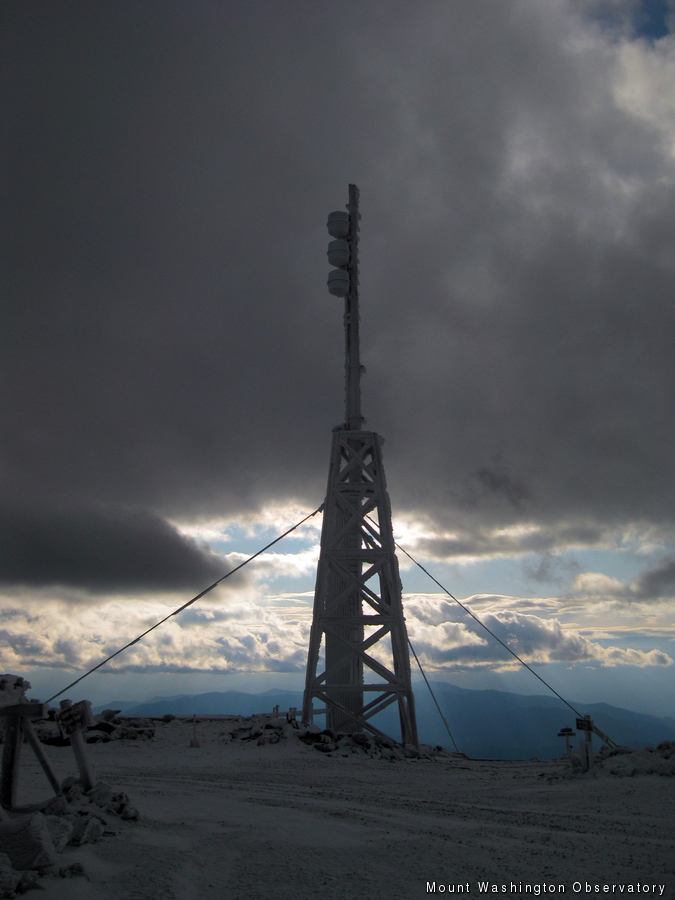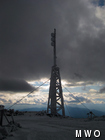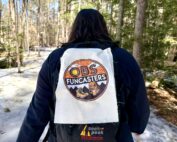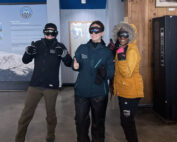A Season of Contrasts; So Know Before You Go!
2011-10-16 18:58:15.000 – Ryan Knapp, Weather Observer/Meteorologist
Some unexpected clearing this afternoon!
Contrast: to compare in order to show unlikeness or differences; note the opposite natures, purposes, etc., of. A black and white photo can show contrasts in light and dark areas of the photo. A picture of a mountain can show a contrast in terrain features. Or a picture from the summit this afternoon can show the contrast of winter weather on the higher summits and fall weather in the valleys. It’s that time of year where contrasts can be seen everywhere around the state through the various displays of fall/early winter colors. While it is a very beautiful time of year, it can also be a very risky time of year for those seeking the higher summits around the state.
Typically, despite the time of year, as hikers scale the summits around the state, the temperatures decrease as they ascend. In the dead of summer, while it is typically cooler on the summits, it’s nothing that a light fleece and maybe some wind pants can’t fix. In the dead of winter, it’s cold at the bases and hikers know that it will only get colder with height; so they start out dressed warmly and (hopefully) pack several layers to adjust as they go up. But in the transition seasons of spring and fall, we see the mix of some well-prepared hikers along with a majority of those that are greatly unprepared. This might be why if you ask any search and rescue official, fall and spring tend to be the most active times of year for them. The reason is the contrast in valley weather compared to summit weather.
The valleys that hikers start in this time of year tend to be mild to warm with temperatures in the 50s and 60s. To the inexperienced hiker, they assume that this will be the conditions on the summit as well and start off greatly unprepared with tennis shoes, blue jeans, tennis shoes, and a sweatshirt. By the time they reach the summits where it is 20 or 30 degrees and in the fog, they are soaked to the bone, shivering and red/pale skinned from the loss of heat. And when they find out that the auto road or cog cannot give them a ride down, the concession is closed and/or they arrive after the building closes, you can see the Kübler-Ross model in motion.
“This can’t be happening; not to me!” (denial). “Why? This isn’t fair! *curse-word*, *curse-word*, *curse-word*” (anger). “Well, How much can I pay you to get me a snack or a ride down?” (bargaining). “Now what? I can’t go on in this state…” (depression). And then, after warming up and resting “I screwed up. Can I buy a sweatshift/flashlight? How do I get down safely?” (acceptance). While not everyone goes through all of these steps or goes through these steps in this order, every unprepared hiker we see and encounter plays out a similar yarn to the personnel up here.
So how do you avoid being an unprepared hiker? Know before you go. Know the weather before you head out. You can get the weather online (that includes smartphones) at our site and/or NWS’s. No internet available? You can get the weather via our weather phone (1800-706-0432 ext1) or by stopping by any of the AMC visitors centers or a slew of other tourist destinations around the valley. Know what to expect on the trails by looking at the trail conditions online or stopping by the AMC visitor centers or other visitor centers. Know what to bring by looking online or asking an experienced hiker. And if still unsure, stop by a help desk and talk things over before heading up. If depending on the Cog or Mount Washington Auto Road for a ride down or the Mount Washington State Park Sherman Adams building for shelter/food, check their sites or call them ahead of time to know their operating schedules. And above all else, know that the mountain will always be here. So if you are inexperienced or unprepared for a certain weather condition or you have to turn around from the weather, remember, you can always try again on a better weather day.
Ryan Knapp, Weather Observer/Meteorologist
Team Flags Return for Seek the Peak’s 25th Anniversary
Team Flags Return for Seek the Peak's 25th Anniversary By MWOBS Staff Mount Washington Observatory is looking forward to continuing a much-loved tradition for Seek the Peak’s 25th Anniversary: Team flags. In inviting teams
Meet Summer Interns Zakiya, Max and Maddie
Meet Summer Interns Zakiya, Max and Maddie By MWOBS Staff We are excited to welcome six teammates to the summit of Mount Washington this summer! During their internship, these students and graduates will play
Saying Goodbye to the Summit
Saying Goodbye to the Summit By Alexis George After an extraordinary last three years working as a Weather Observer and Meteorologist, I am excited to pursue a different career. As sad I as am






